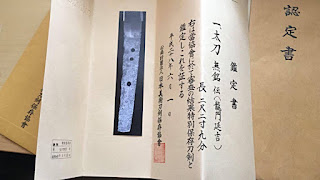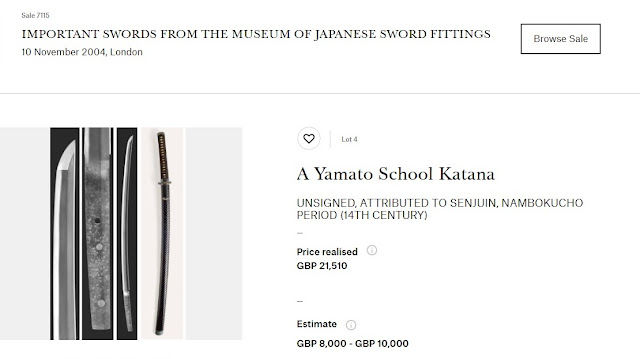N.B.T.H.K. (Nihon Bijutsu Token Hozon Kai)
N.B.T.H.K. (Nihon Bijutsu Token Hozon Kai)
The N.B.T.H.K. (Nihon Bijutsu Token Hozon Kai) was founded in 1948 and is commonly recognized by collectors. They operate the Japanese Sword Museum in Tokyo. The NBTHK shinsa are held only in Japan. The names of their origami have changed over time. The N.B.T.H.K. issued the following types of origami starting in the 1950's.
- KICHO (white papers) - "Important Work"
- TOKUBETSU KICHO (green papers) - "Extraordinary Work"
- KOSHU TOKUBETSU KICHO (blue papers) - "Special Extraordinary Work
- JUYO TOKEN - "Very Important Work"
- TOKUBETSU JUYO - "Extraordinarily Important Work"
This ranking scale was changed in the 1980's. The current system of origami includes the following types:
- HOZON - "Worthy of Preservation"
- TOKUBETSU HOZON - "Extraordinarily Worthy of Preservation"
- JUYO TOKEN - "Very Important Work"
- TOKUBETSU JUYO - "Extraordinarily Important Work"
When I first
bought the Tachi, the Japanese dealer who has sold me the Tachi has promised it to be by Aoe but it has
turned up to be from Ryumon Nobuyoshi 伝龍門延吉太刀. The Ryumon Nobuyoshi is a sword group living in the Yamano County 龍門一派 Ryumon floor, Yamato County, which was the territory of Kofukuji, taking the place name and called (Longmen) Ryumon. I was a little disappointed at first but
the dealer has decided to cut off all communication with me on messenger and he even blocked me.
Without much
choice, I have to seek for help in Nihonto Message Board on 11th Jan 2017.
Stephan C from the forum has kindly recommended Mr Paul Martin, from The
Japanese Sword. On 13th Jan 2017, Paul has immediately replied my message and
given me the various steps and costs. With his kind advice, I have sent the Tachi to him in July 2017 and he has helped me to re-polish the katana to make sure that it is at its best to be submitted for Shinsa.
After much waiting, I have finally received the
good news that it has passed and is now able to be Juyo Token status. It is not
unusual that the planned submission of a sword to Juyo is a years long process,
involving special polish and one may not see the sword for almost a year at
best, or many years at worst. With the right people's help, one can turn a negative situation into positive and the professionalism of Mr. Paul Martin truly demonstrated this.



Comments
Post a Comment